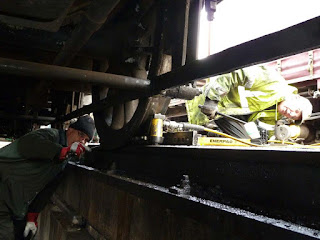We're a daft lot, those of us who volunteer to maintain steam locos. You quickly learn that complaining about things going wrong is waste of breath and simply invites comments such as " Ha, ha, that's steam locos for you!" and others less printable. But it is all done in good humour and when the chips are down most everyone will muck in and help you get the problem sorted. And it can be very mucky work!
A good starting point is that "if nothing looks wrong then you're not looking hard enough" closely followed by "if something can go wrong then it will sooner or later" With that in mind and having a few weeks before the loco is needed for Santa Specials duty, I asked the question "When was the last time we looked the tender axle boxes?" "Er, not recently" was eventually tracked down to mean not since the tender had come back from restoration work at Tyseley - 20 years ago. "Ah" I said and set off for some spanners hoping for inspiration about exactly how one strips down a tender axle box and thinking it couldn't be too different from doing the driving wheel axle boxes which I had done before.
So to work, with the blind (Gilbert) leading the blind (me!) or maybe it was the other way round. Starting with what we knew, we removed the LHS leading axle box cover to expose the brass plate that is white metaled on the face sitting on the axle journal. We inserted 2 bolts into the holes at the end of the plate to draw it out later when had removed the underkeep and lowered the axle Then we removed the nuts on the underkeep bolts. At which point the bolts should be turned lifted and the underkeep withdrawn. 3 behaved perfectly. The 4th just would not be lifted - typical. After quite a few failed attempts and a cuppa we resorted to plan B. Remove the horn guide tie bar below the underkeep and lower the underkeep from its retaining bolts. Easy job.

Next we replaced the tie bar and made a couple of spacers to hold the axle box in place relative to the tie bar. Then we jacked up the end of the tender to allow the axle to drop and free the brass to the point where it could be with drawn through the hole where the cover plate had been removed. Success comes those who persevere!
The white metaling on the brass was found to be in excellent condition. So we got out the new steam pressure washer and cleaned the brass and the axle box underkeep. The brass went in easily enough. Fitting the underkeep should have been straightforward enough except the bolts kept turning and dropping off the locating lugs in the axle boxes as we tried to turn the nuts at the end of the bolts. It was one of those jobs best done by an octopus; we needed more hands. Fortunately Fred turned up in the nick of time and although protesting that he had just cleaned his hands, he saved the day and the battle was won. Job was soon wrapped up after that. SO just another 5 to do...only another 30 hours of work then!




